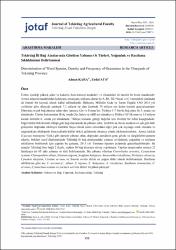| dc.description.abstract | Grape is an important nutrient with its high sugar and calories, some mineral substances and vitamins. It is also regarded as an important source of calcium, potassium, sodium and iron, and vitamins A, B1, B2, Niacin and C . According to the United Nation Food and Agriculture Organization (FAO) 2018 data, 79 million tons of grapes were produced on approximately 7.2 million hectares in the world. Spain, China and France have the largest vineyard areas in the world. Turkey, ranks fifth with 417 thousand ha vineyard. China, Italy and USA are in the top three in terms of production and Turkey ranks 6th with 3.9 million tons production and 5% rate. Turkey, due to its location, is a favourable climate for viticulture. As in other cultivated plants, weeds in vineyards shared many other resources in the environment especially factors that directly affect plant growth such as water, nutrients and light with viticulture and they affect the growth of cultivated plants negatively with the allelopathic chemicals they secrete. In addition, parasitic weeds such as dodder (Cuscuta monogyna) weaken the plants by penetrating directly into the young stems and shoots of the viticulture. This study was carried out in July-August 2015 to determine the weed species, density and frequency of occurrence in the vineyard areas of Tekirdağ province. To do this, survey were realized on an area covering 50 vineyards in two towns of Tekirdag province. As a result of the researches, 65 weed species belonging to 23 families were determined. Among these, Convolvulus arvensis, Cynanchum acutum, Chenopodium album, Solanum nigrum, Sorghum halepense, Amaranthus retroflexus, Portulaca oleracea, Cynodon dactylon, Cirsium arvense. and Setaria viridis were the most frequently determined 10 species. According to their frequencies; Convolvulus arvensis, Chenopodium album, Solanum nigrum, Sorghum halepense, Amaranthus retroflexus, Xanthium strumarium, Cirsium arvense, Cynanchum acutum, Lactuca serriola species came front. © 2021 Namik Kemal University - Agricultural Faculty. All rights reserved. | en_US |



















